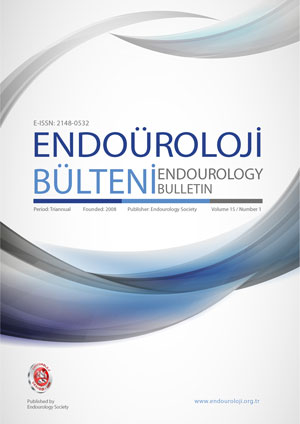
Editorial Board Message
Prof.Dr. R. Gökhan ATIŞ
Editorial Borad
Arbitrators List
Contents
Original Article
Comparison of Retzius Sparing Robot-Assisted Radical Prostatectomy and Conventional Robot-Assisted Radical Prostatectomy in Terms of Surgical Margin Positivity
Ali Kaan Yıldız, Arif Bedirhan Bayraktar, Demirhan Örsan Demir, Turgay Kaçan, Yusuf Gökkurt, Buğra Bilge Keseroğlu, Tolga Karakan
Abstract
Objective: The gold standard treatment for localized prostate cancer is radical prostatectomy, the aim of which is to cure the disease and minimize the side effects of this treatment. The oncological results of retzius-sparing robot-assisted radical prostatectomy, which has fewer side effects, are still controversial compared to the conventional method. This study aimed to compare retzius-sparing robot-assisted radical prostatectomy (Rs-RARP) and conventional robot-assisted radical prostatectomy (C-RARP ) regarding surgical margin positivity.
Material and Methods: Patients who underwent robot-assisted radical prostatectomy with a diagnosis of localized prostate cancer between January 2022 and September 2023 were evaluated retrospectively. The patients were divided into two groups: those who underwent Rs-RARP and those who underwent C-RARP. Early oncological results (ISUP grade, T stage, bladder neck invasion, extracapsular extension, seminal vesicle invasion, lymph node invasion, and surgical margin positivity) were compared in both groups.
Results: A total of 57 patients were included in the study, 26 in the Rs-RARP group and 31 in the C-RARP group. Demographic data and preoperative clinical characteristics of the patients in the two groups were similar. Surgical margin positivity was detected in 34,6% of patients in the Rs-RYRP group and 25,8% of patients in the C-RARP group, and no significant difference was found in both groups (p=0,4). The ISUP grades and T stages of the surgical specimen were similar. No statistically significant difference was observed between the two groups in terms of lymph node invasion, extracapsular extension, seminal vesicle invasion and bladder neck invasion.
Conclusion: Retzius sparing robot-assisted radical prostatectomy is a feasible method for prostate cancer surgery compared to the conventional method in terms of early oncological results. However, more data are needed for long-term oncological outcomes (especially in terms of biochemical recurrence).
Keywords: prostatectomy, retzius-sparing, robotic, surgery, conventional
Original Article
Comparison of Supine and Prone Positions’ Outcomes in Percutaneous Nephrolithotomy
Tugay Aksakalli, Adem Utlu, Saban Oguz Demirdogen, Ahmet Emre Cinislioglu, Feyzullah Celik, Ibrahim Karabulut
Abstract
Objective: The study aimed to compare two different percutaneous nephrolithotomy positions with the evaluation of preoperative demographic data, perioperative findings and surgical outcomes.
Material and Methods: Patients aged 18 years and older with renal stones measuring 2-4 cm who underwent percutaneous nephrolithotomy between January 2019-December 2023 were included in the study. Patients were divided into two groups as supine and prone based on the data obtained from the operation notes. Demographic data such as age, gender, body mass index (BMI), and chronic diseases were compared. Operation time, perioperative complications, and postoperative follow-up data were collected and compared between the two groups.
Results: A total of 105 patients were included in the study, 56 (53%) in the supine group and 49 (47%) in the prone group. Demographic and preoperative data such as age, gender, BMI, stone localization, stone size, and Hounsfield unit were similar. When comparing perioperative findings, surgical time was shorter in the supine group (101 (95-107) min vs. 135 (126-145) min, p<0.001). The mean decrease in hemoglobin was similar in both groups (p>0.05). The most common complication was fever, manifesting in 14 patients (13.3%). The stone-free rate was 83.9% for supine group and 83.6% for prone group (p>0.05).
Conclusion: The choice of position in percutaneous nephrolithotomy may vary depending on the surgeon’s experience. Although supine and prone positions are similar in terms of results, the supine position is associated with shorter operative time.
Keywords: Percutaneous nephrolithotomy, Nephrolithiasis, Supine, Prone
Original Article
Evaluation of the Effect of Balneotherapy (Spa Treatment) on Lower Urinary Tract Symptoms Associated with JJ Stents: A Prospective Placebo-controlled Study
İsmail Emre Ergin, Adem Sancı, Abuzer Öztürk, Aydemir Asdemir, Hüseyin Saygın
Abstract
Objective: Lower urinary tract symptoms related to the JJ stent placed after ureteral stone treatment are among the issues that patients complain about the most after the operation. We aimed to assess the impact of balneotherapy (spa treatment) on lower urinary tract symptoms associated with JJ stents.
Material and Methods: Patients who underwent unilateral ureteral stone treatment and ureteral JJ stent placement were divided into 3 groups after the operation: Control, Tolterodin and Balneotherapy (spa treatment) groups. Post-op 1st week and 4th week ureteral stent symptom scores were measured. Analgesic tablet usage amounts were recorded.
Results: When the groups were compared to each other in the 4th week, analgesic using, urinary symptoms, body pain scores of Tolterodin and Balneotherapy groups were found to be lower than the control group (p<0.001). When the groups were compared between the 1st and 4th weeks, there was no change in the control group, but there was a significant change in the other groups.
Conclusions: In this article, inspired by the behavior of the local people, we see that Balneotherapy provides significant symptom improvement compared to the non-treatment group and gives as good results as other medications, as an easy, low-cost, low-side-effect treatment method that can be recommended to patients in the future.
Keywords: balneotherapy, ureteral catheterization, lithotripsy
Original Article
Can the Neutrophil/Lymphocyte Ratio and Platelet/Lymphocyte Ratio Be Used to Predict the Risk of Ureteral Stricture Following Ureteroscopy?
Reha Ordulu, Mustafa Aydin, Emrah Kucuk, Hakan Yildiz, Mahmut Ulubay, Ekrem Akdeniz, Mustafa Kemal Atilla
Abstract
Objective: The purpose of this study was to investigate whether the neutrophil/lymphocyte ratio (NLR) and platelet/lymphocyte ratio (PLR) can be used to predict the development of ureteral stricture or difficult ureter in patients who had previously undergone endoscopic upper urinary tract surgery.
Materials and Methods: This observational study was performed between April 2022 and April 2023 at the Samsun Training and Research Hospital Urology Department, Türkiye. One hundred thirty patients who had undergone prior endoscopic upper urinary tract surgery were included. These were divided into two groups, with (Group 1) and without (Group 2) ureteral stricture. The diagnosis of ureteral stricture was based on direct endoscopy or retrograde pyelography. The groups’ socio-demographic characteristics, clinical data, and NLR and PLR values were then compared.
Results: The patients’ mean ages were 49.89±14.40 years in Group 1 and 48.92±14.60 in Group 2 (p = 0.704). No statistically significant differences were observed between the groups in terms of sex, body mass index, or comorbidity. However, significant differences were determined in terms of passage of kidney stones and numbers of surgical procedures performed (p = 0.001 and p <0.001, respectively). The groups’ NLR values were 2.62 (0.75-9.18) and 2.29 (0.80-6.67), and their PLR values were 136.57 (55.02-475.45) and 118.66 (37.50-244.17), respectively. The differences between the groups were not statistically significant (p = 0.139 and p = 0.076, respectively).
Conclusion: Although NLR and PLR values were higher in the group with ureteral stricture in this study, that elevation was not statistically significant. The results show that the evaluation of NLR and PLR values are not useful in predicting ureteral stricture in patients who have previously undergone endoscopic upper urinary tract surgery.
Keywords: ureteral stricture, difficult ureter, neutrophil/lymphocyte ratio, platelet/lymphocyte ratio
Review
Medical Treatment for Urinary System Stones
Hasan Turgut, Mehmet Sarıer
Abstract
In urinary tract stone disease, medical treatment is of great importance both to increase stone passage and to prevent recurrence. Adequate fluid intake, dietary habits, increased fiber intake, low vitamin C and protein intake can be recommended in all patients with urolithiasis regardless of stone type. Pharmacologic agents such as alpha blockers and calcium channel blockers have been used for a long time to increase spontaneous passage of urinary tract stones. Medical treatment of calcium stones includes thiazides, alkaline citrate, allopurinol and glycosaminoglycans. Urine alkalinization, restriction of protein and purine intake in the diet and allopurinol are used in the medical treatment of uric acid stones. Urine alkalinization, cystine binding drugs and restriction of methionine intake are effective in cystine stones. Urease inhibitors, antibiotics and urine acidification are commonly used methods in the medical treatment of infection stones
Keywords: kidney stone, diet therapy, ureteral stone, renal colic, medical expulsive therapy, metaphylaxis
Correction
Correction to: Efficacy of Biphasic Fluid Therapy in Robot-Assisted Kidney Transplantation
Nalan Saygı Emir
Abstract
In the first published version of this article (1), the author stated that contributors name was misspelled. This article is single authored. The author take full responsibility for this confusion, and they apologize for the confusion.
Publisher’s Note: The original article has been corrected, and a correction note was added.
REFERENCES
- Saygı Emir N. Efficacy of “Biphasic Fluid Therapy” in Robot-Assisted Kidney Transplantation. Endourol Bull. 2023;15(3):125-138. https://doi.org/10.54233/endouroloji.20231503-1345663










